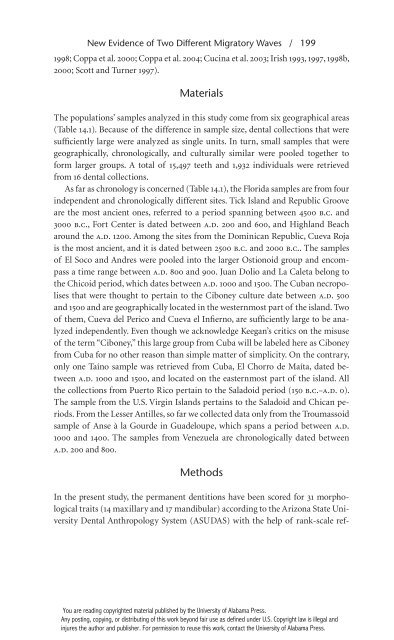Crossing the Borders: New Methods and Techniques in the Study of Archaeological Materials from the Caribbean
by Corrine L. Hoffman, et. al.
by Corrine L. Hoffman, et. al.
Create successful ePaper yourself
Turn your PDF publications into a flip-book with our unique Google optimized e-Paper software.
<strong>New</strong> Evidence <strong>of</strong> Two Different Migratory Waves / 199<br />
1998; Coppa et al. 2000; Coppa et al. 2004; Cuc<strong>in</strong>a et al. 2003; Irish 1993, 1997, 1998b,<br />
2000; Scott <strong>and</strong> Turner 1997).<br />
<strong>Materials</strong><br />
The populations’ samples analyzed <strong>in</strong> this study come <strong>from</strong> six geographical areas<br />
(Table 14.1). Because <strong>of</strong> <strong>the</strong> difference <strong>in</strong> sample size, dental collections that were<br />
sufficiently large were analyzed as s<strong>in</strong>gle units. In turn, small samples that were<br />
geographically, chronologically, <strong>and</strong> culturally similar were pooled toge<strong>the</strong>r to<br />
form larger groups. A total <strong>of</strong> 15,497 teeth <strong>and</strong> 1,932 <strong>in</strong>dividuals were retrieved<br />
<strong>from</strong> 16 dental collections.<br />
As far as chronology is concerned (Table 14.1), <strong>the</strong> Florida samples are <strong>from</strong> four<br />
<strong>in</strong>dependent <strong>and</strong> chronologically different sites. Tick Isl<strong>and</strong> <strong>and</strong> Republic Groove<br />
are <strong>the</strong> most ancient ones, referred to a period spann<strong>in</strong>g between 4500 b.c. <strong>and</strong><br />
3000 b.c., Fort Center is dated between a.d. 200 <strong>and</strong> 600, <strong>and</strong> Highl<strong>and</strong> Beach<br />
around <strong>the</strong> a.d. 1200. Among <strong>the</strong> sites <strong>from</strong> <strong>the</strong> Dom<strong>in</strong>ican Republic, Cueva Roja<br />
is <strong>the</strong> most ancient, <strong>and</strong> it is dated between 2500 b.c. <strong>and</strong> 2000 b.c.. The samples<br />
<strong>of</strong> El Soco <strong>and</strong> Andres were pooled <strong>in</strong>to <strong>the</strong> larger Ostionoid group <strong>and</strong> encompass<br />
a time range between a.d. 800 <strong>and</strong> 900. Juan Dolio <strong>and</strong> La Caleta belong to<br />
<strong>the</strong> Chicoid period, which dates between a.d. 1000 <strong>and</strong> 1500. The Cuban necropolises<br />
that were thought to perta<strong>in</strong> to <strong>the</strong> Ciboney culture date between a.d. 500<br />
<strong>and</strong> 1500 <strong>and</strong> are geographically located <strong>in</strong> <strong>the</strong> westernmost part <strong>of</strong> <strong>the</strong> isl<strong>and</strong>. Two<br />
<strong>of</strong> <strong>the</strong>m, Cueva del Perico <strong>and</strong> Cueva el Infierno, are sufficiently large to be analyzed<br />
<strong>in</strong>dependently. Even though we acknowledge Keegan’s critics on <strong>the</strong> misuse<br />
<strong>of</strong> <strong>the</strong> term “Ciboney,” this large group <strong>from</strong> Cuba will be labeled here as Ciboney<br />
<strong>from</strong> Cuba for no o<strong>the</strong>r reason than simple matter <strong>of</strong> simplicity. On <strong>the</strong> contrary,<br />
only one Taíno sample was retrieved <strong>from</strong> Cuba, El Chorro de Maíta, dated between<br />
a.d. 1000 <strong>and</strong> 1500, <strong>and</strong> located on <strong>the</strong> easternmost part <strong>of</strong> <strong>the</strong> isl<strong>and</strong>. All<br />
<strong>the</strong> collections <strong>from</strong> Puerto Rico perta<strong>in</strong> to <strong>the</strong> Saladoid period (150 b.c.–a.d. 0).<br />
The sample <strong>from</strong> <strong>the</strong> U.S. Virg<strong>in</strong> Isl<strong>and</strong>s perta<strong>in</strong>s to <strong>the</strong> Saladoid <strong>and</strong> Chican periods.<br />
From <strong>the</strong> Lesser Antilles, so far we collected data only <strong>from</strong> <strong>the</strong> Troumassoid<br />
sample <strong>of</strong> Anse à la Gourde <strong>in</strong> Guadeloupe, which spans a period between a.d.<br />
1000 <strong>and</strong> 1400. The samples <strong>from</strong> Venezuela are chronologically dated between<br />
a.d. 200 <strong>and</strong> 800.<br />
<strong>Methods</strong><br />
In <strong>the</strong> present study, <strong>the</strong> permanent dentitions have been scored for 31 morphological<br />
traits (14 maxillary <strong>and</strong> 17 m<strong>and</strong>ibular) accord<strong>in</strong>g to <strong>the</strong> Arizona State University<br />
Dental Anthropology System (ASUDAS) with <strong>the</strong> help <strong>of</strong> rank- scale ref-<br />
You are read<strong>in</strong>g copyrighted material published by <strong>the</strong> University <strong>of</strong> Alabama Press.<br />
Any post<strong>in</strong>g, copy<strong>in</strong>g, or distribut<strong>in</strong>g <strong>of</strong> this work beyond fair use as def<strong>in</strong>ed under U.S. Copyright law is illegal <strong>and</strong><br />
<strong>in</strong>jures <strong>the</strong> author <strong>and</strong> publisher. For permission to reuse this work, contact <strong>the</strong> University <strong>of</strong> Alabama Press.


















